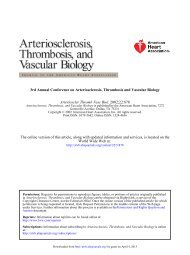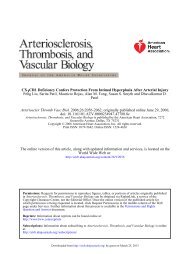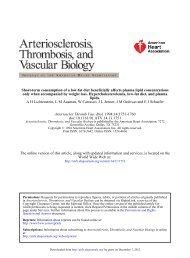Bloch and Richard T. Lee P. Christian Schulze, Heling Liu, Elizabeth ...
Bloch and Richard T. Lee P. Christian Schulze, Heling Liu, Elizabeth ...
Bloch and Richard T. Lee P. Christian Schulze, Heling Liu, Elizabeth ...
You also want an ePaper? Increase the reach of your titles
YUMPU automatically turns print PDFs into web optimized ePapers that Google loves.
activity. NO <strong>and</strong> mutation of thioredoxin at Cys69, a site of<br />
nitrosylation, had no effect on the ability of Txnip to interact<br />
with thioredoxin. Our findings reveal a novel NO-mediated<br />
mechanism independent of S-nitrosylation leading to enhanced<br />
thioredoxin function.<br />
Methods <strong>and</strong> Results<br />
Methods<br />
Cell Culture<br />
Primary cultures of RPaSMC were prepared from adult Sprague-<br />
Dawley rats as previously described. Cells were exposed to<br />
S-nitroso-glutathione (GSNO) (100 mol/L), PAPA NONOate<br />
(NOC-15) (500 mol/L), <strong>and</strong> S-nitroso-N-acetylpenicillamine<br />
(SNAP) (100 mol/L); 1H-[1,2,4]oxadiazolo-[4,3-a]quinoxalin-1one<br />
(ODQ) (10 mol/L), an inhibitor of guanylate cyclase, 19 for<br />
varying durations. Transfection of 293 cells was performed at 70%<br />
confluence followed by incubation for 48 hours.<br />
Northern Analysis<br />
RNA was extracted from RPaSMC <strong>and</strong> mRNA expression detected<br />
using specific cDNA probes against thioredoxin, Txnip, <strong>and</strong> thioredoxin<br />
reductase.<br />
Quantitative Real-Time Polymerase Chain Reaction<br />
Txnip gene expression was analyzed by real-time polymerase chain<br />
reaction (LightCycler, Roche) using specific oligonucleotides<br />
against Txnip <strong>and</strong> -tubulin.<br />
Western Analysis<br />
RPaSMC were harvested, cellular proteins isolated, <strong>and</strong> 50 g of<br />
protein subjected to gel electrophoresis followed by transfer to<br />
nitrocellulose membranes. The membranes were blocked 5% nonfat<br />
milk/phosphate-buffered saline <strong>and</strong> then incubated with antibodies<br />
directed against Txnip, thioredoxin reductase, or thioredoxin.<br />
Nuclear Run-off Experiments<br />
Nuclear run-off assays were performed as previously described. 20<br />
cDNA probes were created using oligonucleotides for Txnip,<br />
-tubulin, <strong>and</strong> thioredoxin.<br />
mRNA Stability<br />
Cells were pretreated with actinomycin D before stimulation. RNA<br />
was extracted <strong>and</strong> gene expression measured as described before. 21<br />
Plasmid Construction <strong>and</strong> Transient<br />
Transfection Experiments<br />
The human Txnip promoter region including 1777 bp upstream of<br />
the ATG start codon was cloned from human genomic DNA using<br />
primers 1 to 6 (supplemental Table I, available online at http://<br />
atvb.ahajournals.org). Transcriptional activity was assessed under<br />
stimulation with GSNO at 5.6 mmol/L <strong>and</strong> 22.4 mmol/L glucose.<br />
Further, full-length human Txnip was cloned into a mammalian<br />
expression vector (pcDNA3.1, Invitrogen). Expression plasmids for<br />
human wild-type thioredoxin or mutant thioredoxin with a serine<br />
replacing cysteine 69 (C69S) were kindly provided by Dr Judith<br />
Haendeler (Molecular Cardiology, University of Frankfurt, Germany).<br />
Equal amounts of empty expression plasmids served as<br />
control vectors.<br />
Immunoprecipitation<br />
Protein G sepharose beads were incubated with anti-Txnip antibody<br />
<strong>and</strong> equal amounts of total protein lysates were incubated with<br />
antibody-bead complexes for 2 hours rotating at 4°C. Beads were<br />
washed 3 times, resuspended, <strong>and</strong> the supernatant electrophoresed.<br />
Signals were visualized by enhanced chemiluminescence.<br />
Thioredoxin Activity Assay<br />
Thioredoxin activity was measured using the insulin disulfide<br />
reduction assay as previously described. 12<br />
<strong>Schulze</strong> et al NO Regulates Thioredoxin Through Txnip 2667<br />
Measurement of Oxidative Stress<br />
Cells were incubated with 2,7-DCFDA for 45 minutes, washed in<br />
phosphate-buffered saline, <strong>and</strong> fluorescence measured using a fluorometer<br />
(Perkin Elmer) at 595 nm.<br />
Statistical Analysis<br />
All experiments were performed at least 3 times <strong>and</strong> data are<br />
expressed as meanSD. Data were analyzed by Student t test or<br />
1-way ANOVA with post-hoc analysis. P0.05 was considered<br />
statistically significant.<br />
Results<br />
NO Reduces Txnip <strong>and</strong> Enhances Thioredoxin<br />
Reductase Gene Expression<br />
We performed Northern analyses using total RNA prepared<br />
from RPaSMC exposed to GSNO (100 mol/L for 1, 2, 4, 6,<br />
<strong>and</strong> 16 hours; 0, 10, 100, <strong>and</strong> 500 mol/L for 2 hours). GSNO<br />
decreased Txnip gene expression <strong>and</strong> increased thioredoxin<br />
reductase gene expression in a time- <strong>and</strong> dose-dependent<br />
manner in RPaSMC. Txnip mRNA levels decreased rapidly<br />
within 1 hour after exposure to GSNO (7118%) <strong>and</strong><br />
returned to baseline 4 hours after exposure to GSNO (Figure<br />
1A). Txnip mRNA levels decreased in RPaSMC exposed to<br />
100 mol/L <strong>and</strong> 500 mol/L of GSNO for 2 hours (Figure<br />
1B). Thioredoxin reductase mRNA levels increased in<br />
RPaSMC within 2 hours after exposure to GSNO (2.70.2fold)<br />
<strong>and</strong> returned to baseline 16 hours after exposure to<br />
GSNO (Figure 1A). The thioredoxin reductase mRNA levels<br />
increased with 100 mol/L <strong>and</strong> 500 mol/L GSNO after 2<br />
hours of exposure (Figure 1B).<br />
NO Decreases Txnip Protein Levels, Increases<br />
Thioredoxin Reductase Levels, <strong>and</strong> Enhances<br />
Thioredoxin Activity<br />
Incubation of RPaSMC with GSNO decreased Txnip protein<br />
levels in a time- <strong>and</strong> dose-dependent manner (Figure 1C).<br />
Further, protein levels of thioredoxin reductase increased<br />
under GSNO stimulation (Figure 1D). The suppression of<br />
Txnip was also induced by treatment of RPaSMC with the<br />
NO donor compounds NOC-15 <strong>and</strong> SNAP (Figure 1E). In<br />
contrast, endogenous thioredoxin protein levels in RPaSMC<br />
remain unchanged throughout 4 hours of GSNO incubation<br />
(Figure 1C).<br />
To examine the mechanisms by which NO regulates Txnip<br />
<strong>and</strong> thioredoxin reductase gene expression, we evaluated the<br />
role of soluble guanylate cyclase. RPaSMC were exposed to<br />
100 mol/L of GSNO for 2 hours (Txnip) <strong>and</strong> 4 hours<br />
(thioredoxin reductase) in the presence or absence of the<br />
soluble guanylate cyclase inhibitor ODQ at a concentration<br />
previously shown to inhibit guanylate cyclase in RPaSMC<br />
(10 mol/L). 19 Pretreatment with ODQ did not inhibit the<br />
GSNO-mediated changes in Txnip or thioredoxin reductase<br />
gene expression (Figure 1F). ODQ itself had no effect on<br />
gene expression of Txnip or thioredoxin reductase.<br />
The changes in gene <strong>and</strong> protein expression of Txnip <strong>and</strong><br />
thioredoxin reductase predict that GSNO will increase thioredoxin<br />
activity in RPaSMC. Consistent with previous findings<br />
in endothelial cells, 14 GSNO increased thioredoxin activity in<br />
RPaSMC. Incubation with 100 mol/L GSNO increased<br />
thioredoxin activity levels 1.60.3-fold at 1 hour (P0.02<br />
Downloaded from<br />
http://atvb.ahajournals.org/ by guest on July 30, 2013














